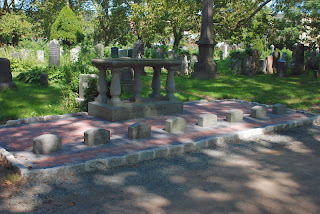Another autumn event on the Magpie Mason’s schedule is
Grand Master’s Day at Tappan. On Sunday, October 11, MW Edward Gilbert, Grand Master of New York, will welcome the brethren to
DeWint House, the Revolutionary War historic site owned and operated by the
Grand Lodge of New York. Appropriately for Masons, it is located in a county called Rockland.
Never been there, so I don’t know what to expect, but there will be a brunch at 11 a.m. at
Old ’76 House, reputed to be the oldest tavern in New York – and
that’s saying something! – having served the public since 1686. The festivities at DeWint House will begin at 2 p.m.
What the two historic sites share in common is the treason of
Gen. Benedict Arnold. You know the story: the once admired Continental Army general betrayed the Revolution by attempting to help the British capture the West Point garrison. His contact was Major John André, who was captured, tried and executed for his espionage. DeWint House repeatedly served as a headquarters for George Washington, including during the trial and execution of André in 1780, while Old ’76 House was known as “André’s prison” because he was incarcerated there during his trial.


Left: Old ’76 House. Right: DeWint House. Both are located in historic Tappan, in Rockland County, New York, just a few minutes over the New Jersey border. Come October, the landscape should be beautiful, with the leaves turning and the air acquiring its autumnal chill.
DeWint House is the oldest surviving structure in Rockland County, and is renowned as an excellent showcase of
Dutch Colonial architecture. It has been owned and operated by New York Freemasonry for more than 60 years. In 1966 it was added to the
National Register of Historic Places. The adjacent Carriage House serves as the visitors center and offers many exhibits of George Washington and other historic interests.
An additional Masonic link is the 20° of the AASR, titled “Master ad Vitam.” The degree has been rewritten a number of times during the past two centuries. In 1896, a drama was added that told a fictional story of Frederick II of Prussia visiting a lodge in 1763. A story within the drama tells of a spy who gains entrance to the lodge with a patent that actually was a map of a fortress. The spy escapes, but a Gen. Wallraven was caught and sentenced to life in prison for his complicity in the espionage. His sentence is reduced to exile.
In the aftermath of World War I, when American sentiment toward people and things German was cold, and when Masonic lodges banned the German language from lodge activities, this degree was rewritten again, with a new setting and new historical characters, substituting Washington for Frederick the Great, and Arnold taking the place of Wallraven.
I wonder if the New York Scottish Rite brethren ever conferred this degree at DeWint House. Seems like a natural fit.
 The October 21 Stated Communication of St. John’s Lodge No. 1, AYM will feature RW Bro. Robert L. Barrows, Grand Organist, who will present his lecture titled “Music in Ritual.”
The October 21 Stated Communication of St. John’s Lodge No. 1, AYM will feature RW Bro. Robert L. Barrows, Grand Organist, who will present his lecture titled “Music in Ritual.”






















































































